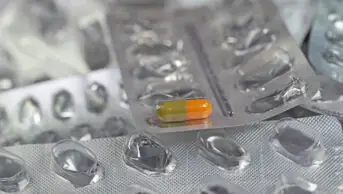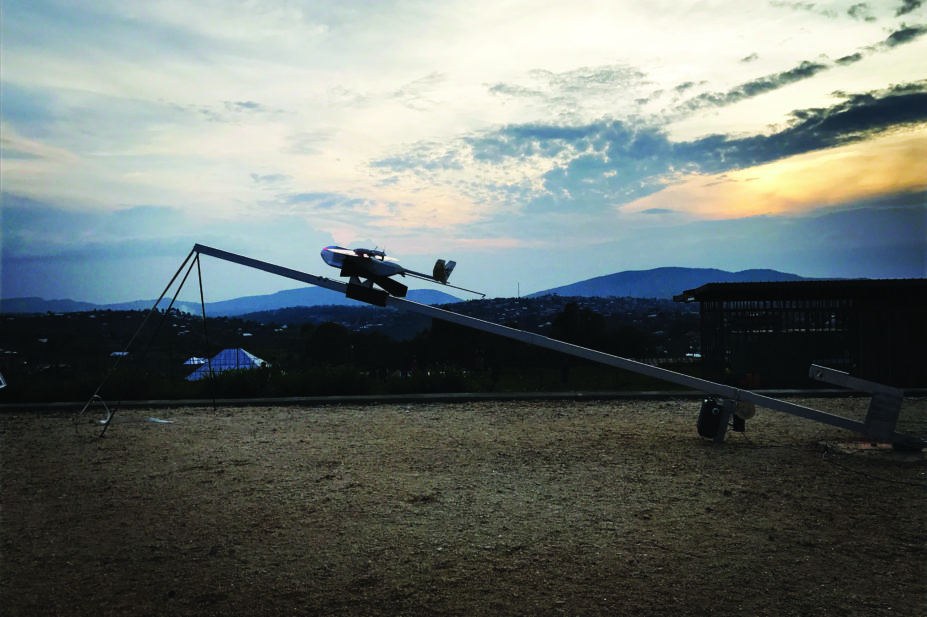
Zipline
Think of skies buzzing with flying drones, and you’ll probably imagine something out of a dystopian science-fiction novel. Whether it’s a coercive future police state observing and controlling its population or, even today, military operations using drones for reconnaissance and air strikes, these flying robots can make people feel uneasy. But our view of drones may be about to change. With companies such as online-shopping store Amazon testing the use of drones to deliver goods, humanitarian organisations are asking whether the fledging technology could be used to deliver medicines and other essential supplies to hard-to-reach places.
There is certainly a need. The global humanitarian crisis is the largest since the end of the Second World War, with more than 20 million people in four countries facing starvation and famine. With resources spread thin, the United Nations has stressed the need for humanitarian organisations to focus on innovation. The use of drones to deliver drugs to people fits that bill.
“You could really see how having drones deliver medicines to places we’d otherwise find difficult to reach would be useful,” says Owen Wood, humanitarian pharmacy adviser at UK-based global charity Save the Children. Such instances might be the delivery of drugs to areas with no roads, whether they’ve not been built or they’ve been destroyed by a natural disaster. It would also be tempting to send unmanned cargo drones into dangerous war zones.
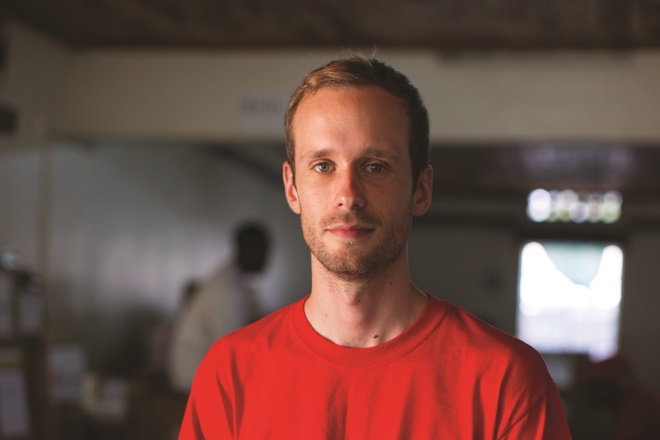
Source: Save the Children
Owen Wood, humanitarian pharmacy adviser at UK-based global charity Save the Children, says that he can see how having drones deliver medicines to places they would otherwise find difficult to reach would be useful, but he has some concerns
The case for drones is not restricted to developing countries. Could they be used to deliver an emergency asthma inhaler to a child living in the centre of London? Can they deliver drugs to people with disabilities who struggle to get to their community pharmacy? In 2014, the value of the global commercial drone market was €450m [about £400m]; it is expected to almost quadruple to €1.8bn [£1.63bn] by 2022 — so there is a substantial financial carrot to tempt companies to come up with innovative solutions[1]
.
You could really see how having drones deliver medicines to places we’d otherwise find difficult to reach would be useful
Drones on the market fall into three categories. Fixed-wing drones travel furthest and can carry the heaviest loads at around 1–3kg. Like aeroplanes, though, they require take-off and landing strips, which means their use is limited in forested or mountainous areas. Multi-copter drones (those with more than one propeller) can take off and land vertically but at the cost of shorter flight times and lighter payloads of around 1kg. Newer hybrid drones offer the benefits of both but are more expensive. Still, with the cost of any of these drones at between €10k [£9,000] and €60k [£54,000], they are not beyond the reach of humanitarian organisations.
There is much progress still to be made. The short flight times and light payloads should get better with time. Less certain are financial concerns: who will pay for these drones and will they become more cost effective than a fleet of motor bikes or on-foot delivery teams? The perception of drones as alien or military machines might also be a stumbling block, as might the leniency of aviation authorities when granting airspace. Drones have a difficult path ahead, but there are enough instances where the case for their use is undeniable.
Emergency — drones to the rescue
One such application is the delivery of post-exposure rabies vaccination in rural communities. Rabies is 100% preventable if a person is vaccinated within 24 hours of being bitten, yet an estimated 59,000 people die each year, mostly children in underserved, rural parts of Africa and Asia.
“One of the biggest challenges when you look at the vaccine supply chain, especially with rabies where even temporary stock outages cost lives, is how you reach that last mile,” says Moz Siddiqui, a health innovations manager at Gavi, the Vaccine Alliance, a public–private global health partnership committed to increasing access to immunisation in poor countries.

Source: Courtesy of Moz Siddiqui
Moz Siddiqui, a health innovations manager at Gavi, the Vaccine Alliance, says that one of the biggest challenges when you look at the vaccine supply chain is how you reach that last mile
In September 2016, in collaboration with US delivery company UPS and drone manufacturer Zipline, Gavi began testing drones to deliver lightweight packages to health centres in mountainous Rwanda, known as the land of a thousand hills, where access by road can be difficult. “The important thing about this Rwandan project is that the government is leading it, which means the military and the aviation authorities are granted permission to fly drones out of the line of sight,” says Siddiqui.
Zipline’s fixed-wing drones, known as Zips, have been making the approximately hour-long round trip from a distribution centre to 21 clinics in the west of the country. In this first phase, they are delivering chilled blood packets by parachute, following a request by health workers on a smart device. If testing is successful, they will begin delivering post-exposure rabies vaccination to health centres reporting bites from suspected rabid animals. Siddiqui says this second-phase testing could begin before the end of 2017.
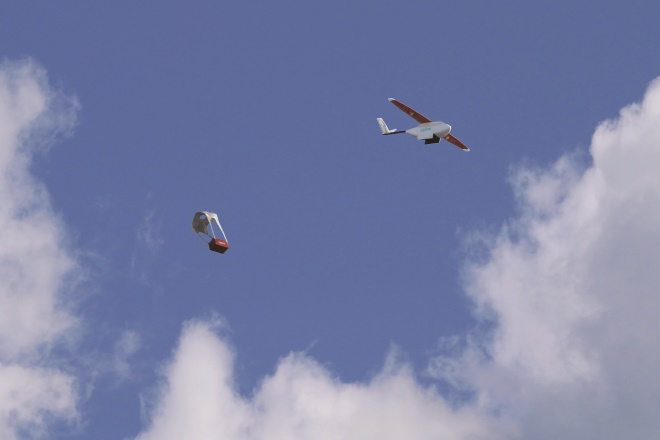
Source: Zipline
Zipline’s fixed-wing drones, known as Zips, have been making the approximately hour-long round trip from a distribution centre to 21 clinics in the west of Rwanda to deliver chilled blood packets by parachute
The blood-delivery trials will answer important questions about whether the drones are reliable; how drone-delivery systems can integrate with existing supply chains; and whether they will be cost effective. “Even if the costs are slightly more than normal delivery,” says Siddiqui, “it may be worth the extra cost if it means the vaccines will be making that last mile of delivery whereas otherwise they wouldn’t. We’ll need the data on that.”
Cost-effectiveness analyses of the project are not yet finished, says Siddiqui: “It is proving attractive, let’s put it that way,” he says. These preliminary data from Rwanda are backed up by findings from a computer modelling study showing that drones could be a cost-effective delivery mechanism over traditional road delivery for vaccines in some instances[2]
.
You can see how drones can bring efficiencies into a system, but these are early days — we’re at the beginning of a learning curve
Speaking more generally about the use of drones for vaccines, Siddiqui says: “Do we think drones could be used for routine vaccinations? Not at this stage, it’s too early to tell. However, do we think they could be used for supplementary campaigns and catch-up days? Yes, quite possibly.” In this way, a vaccination worker could order exactly the number of vaccines needed once they see how many children turn up, meaning they are relieved of any logistical headaches and fewer vaccines will go to waste. “You can see how drones can bring efficiencies into a system, but these are early days — we’re at the beginning of a learning curve,” says Siddiqui.

Source: Zipline
Chilled blood packets are delivered by drone following a request by health workers on a smart device
Learning and refining
Others are learning, too. Matternet is a Californian start-up that makes a quadcopter drone. Entrepreneur Andreas Raptopoulos founded the company in 2011 with a specific goal in mind. “Our vision is to transform the way health is delivered in places with underdeveloped infrastructure,” he says. “The [drone] technology, which needs only power and cellular telephony, can be a leapfrog one in developing countries and can save the billions of dollars needed to build and maintain roads.”
The [drone] technology, which needs only power and cellular telephony, can be a leapfrog one in developing countries and can save the billions of dollars needed to build and maintain roads
In 2013, Raptopoulos did a TED talk that caught the eye of the prime minister of Bhutan, Tshering Tobgay. There are few roads in Himalayan Bhutan, most of which snake up into the mountains and are regularly cut off by snowfall in winter. In 2014, Togbay invited the World Health Organization and Matternet to be involved in a short pilot to transport medical items from a central hospital in Timphu, the capital, to satellite clinics.
“The technology worked well, and the drone flight took about a fifth of the time it would have taken by road,” says Raptopoulos. The project, however, hit a snag when it came to funding. “[The Bhutan government] had so many other needs in development and pharmaceutical [procurement] that were higher priorities.”
Later in 2014, Matternet worked with Médecins Sans Frontières (MSF) in Papua New Guinea to collect and deliver sputum samples to monitor the spread of multi-drug resistant tuberculosis. The project proved unsuccessful this time because Matternet’s drones could not travel far enough without needing to recharge. Some centres on the island are more than 40km apart: Matternet’s drones can travel only 20km between charges. Without a sufficient network of power sources, Raptopoulos realised it was too early for his technology in Papua New Guinea.
“We have changed our business plan fundamentally,” he says. “We want to help in developing countries but only if it works in a sustainable way. In these places, we need a system where we can go there, set it up and then forget about it because we know it is reliable.” He says it could take another 5 years and US$100,000 [£75,000] before they get there. “To drive this progress, it put us on a different track. We are now aiming at developed economies.”
To drive this progress, it put us on a different track. We are now aiming at developed economies
In March, the company received clearance from the Swiss aviation authority to fly unmanned drones over cities in Switzerland at day or night. With its partner there, Swiss Post, it has been doing test runs transporting blood between two hospitals in Lugano, in the mountainous south of the country, making tweaks to the drones’ landing and take-off technology before scaling up operations. The company is also in discussions with potential clients and aviation authorities in other European countries, in America and in Japan.
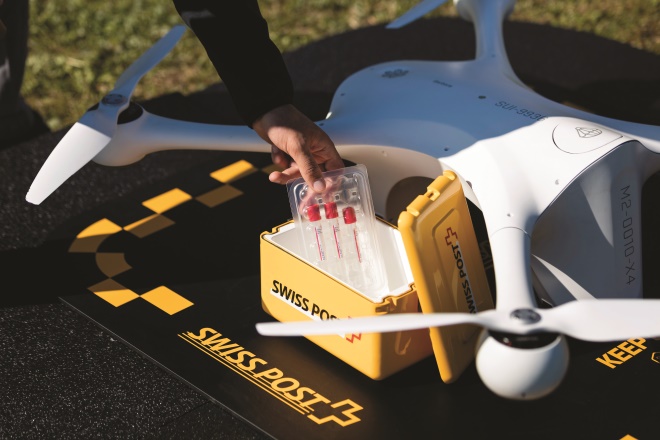
Source: Matternet
Matternet, along with partner Swiss Post, is testing transport of blood products via drones between two hospitals in Lugano, in the mountainous south of Switzerland
The business case in such countries, where existing delivery infrastructure works well, is less clear. Raptopoulos thinks his company’s automated system could offer clients savings in labour costs. “We want to make them a system that works like a pneumatic tube but over longer distances,” he says. Other than emergency supplies such as blood, he says that hospitals might benefit from storing expensive drugs centrally and distributing them when needed.
Any plans would have to first be rubber-stamped by aviation authorities. “[An aviation authority’s] job is to protect public safety, so doing things fast is not in their job description,” says Raptopoulos, who remains confident. “But we fly lower than manned vehicles so it should not interfere with other airspace. If our drones crash, the risk of somebody being injured is very small compared with a plane or helicopter.” In carrying blood products, a drone crash could be a potential biohazard, so authorities will need to be confident of their reliability. The hope is that with enough successful test runs done in countries such as Switzerland, other aviation authorities will be more confident in giving permission.
Into the real world
Ultimately, the use of drug-carrying drones will be shaped by real-world needs. “There are times in the rainy season in places such as the Democratic Republic of the Congo where you have to drive through mud for 10 hours to deliver drugs,” says humanitarian pharmacist Wood. “In cases like that, having a drone to do that for you would be incredibly useful but I’d have to be confident that the drugs wouldn’t be intercepted or that the people I’m delivering them to are fully trained.”
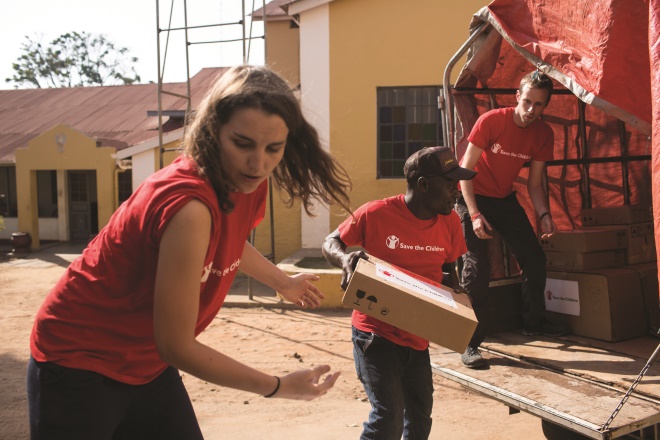
Source: Save the Children
Save the Children provides mostly primary care medications, basic surgical equipment and, where needed, diabetes or hypertensive drugs. Sending a few kilograms of these supplies at a time would not be useful for day-to-day operations, says Owen Wood, a humanitarian pharmacy adviser for the charity (far right)
The need to ensure that trained people are at the receiving end of a drone delivery limits their use in extending drug supply to chronically underserved areas where traditional infrastructure and development of health capacity would be more urgent. “My job as a pharmacist is to ensure the safe and effective use of medicine,” he says. “It would be irresponsible of me to send out medications such as antibiotics or pain relief to untrained people.”
I’d have to be confident that the drugs wouldn’t be intercepted or that the people I’m delivering them to are fully trained
Save the Children provides mostly primary care medications, basic surgical equipment and, where needed, diabetes or hypertensive drugs. Sending a few kilograms of these supplies at a time, Wood says, would not be useful for day-to-day operations or when delivering care to areas such as the horn of Africa where a major requirement is bulky, heavy therapeutic food.
“Drones would be more of a ‘nice to have’ rather than a ‘must have’,” he says. “They might be one of those things where you see it on paper and it looks amazing but when you drill down and look at the challenges around it, it might not be that much of an improvement on what we have now.” There’s another big barrier. “We do a lot of our work in politically unstable places where using drones would cause more of a problem than it’s worth.”
For many people, drones are associated with bombing or military surveillance. “We have to be sensitive to military application of drones, especially in the Middle East and Pakistan,” says Gavi’s Siddiqui. “The society just wouldn’t be ready for it.” Warring factions might also mistake a drug-delivery drone for a military one and shoot it down, or they might think it’s carrying out surveillance. “In these places, there are bigger problems anyway. To be in a position where drones can help is entirely contingent on the actual supply chain working: having a cold chain across the country, hiring the right people and having the right data about stock levels fed up and down the chain. That’s where effort is needed, not drones.”
Different business models and solutions for different markets
With each step change in drone technology or regulation, says Oriol López Guirao, who works in logistics for MSF and runs MSF’s tuberculosis project in Papua New Guinea, the applicability of drones will open to new uses. Since the unsuccessful test project with Matternet in 2014, drone technology has matured such that the organisation is in discussion with two drone manufacturers, both of which produce hybrid drones that can span distances greater than the 43km required and also do vertical take-offs and landings: Vayu (Ypsilanti, Michigan, USA) and Quantum Systems (Munich, Germany). He hopes to begin testing with one of the manufacturers later in 2017.
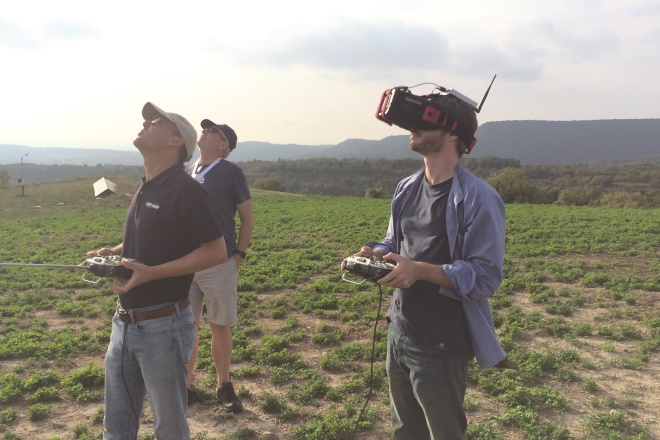
Courtesy of Oriol López
Oriol López Guirao (far right), who works in logistics for Médecins Sans Frontières, says that, in 5 years’ time, he expects drones that can carry 20kg or 40kg not only working on the last mile but supporting the supply chain on a hub-to-hub transport of medicines and other items
“For this project, we have very specific requests and these low-maintenance and easy to use electric drones are what we need,” he says. “In 5 years’ time, I expect drones that can carry 20kg or 40kg not only working on the last mile but supporting the supply chain on a hub-to-hub transport of medicines and other items.”
Raptopoulos believes public perception of drones in rich countries will also be important, whether they’re delivering drugs or other goods. “I live in Palo Alto, it’s a nice area in California, I don’t know how happy my neighbour is going to be if I have a DVD delivered to me at 11 at night,” he says. “There’s a noise they make, not a big one but it’s there, and I think we’ll see some experiments fail because of that.”
There’s a noise they make, not a big one but it’s there, and I think we’ll see some experiments fail because of that
Such concerns are by no means a death knell in the case for drones delivering medication or other health care supplies. “It’s early days,” says Siddiqui, “but when people know somebody who has had their life saved by these drones, they will start to think of them as flying ambulances and they will be more willing to accept them.”
Panel: Will drones ever be used to deliver medicines in the UK?
“A couple of years ago, I wouldn’t have thought [using drones to deliver medicines] was possible,” says Gino Martini, professor of pharmaceutical innovation at King’s College London. “But having seen the advances in drone systems makes me think there might be something in it,” he says. “You could especially see how drones would fit into a hub-and-spoke model of pharmacy — it could really help avoid road congestion in built-up areas — or how they could get important supplies to more remote areas.”

Source: King’s College London
Gino Martini, professor of pharmaceutical innovation at King’s College London, says that he can see how drones would fit into a hub-and-spoke model of pharmacy or how they could get important supplies to more remote areas
References
[1] Swiss Foundation for Mine Action. Drones in humanitarian action: a guide to the use of airborne systems in humanitarian crises. Available at http://drones.fsd.ch/wp-content/uploads/2016/11/Drones-in-Humanitarian-Action.pdf (accessed August 2017)
[2] Haidaria L, Brown S, Ferguson M et al. The economic and operational value of using drones to transport vaccines. Vaccine 2016;34:4062–4067. doi: 10.1016/j.vaccine.2016.06.022
